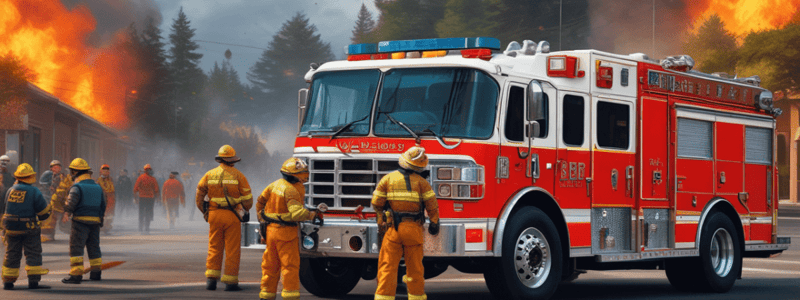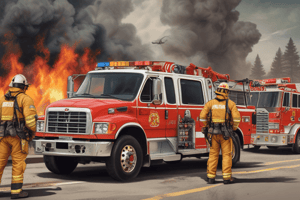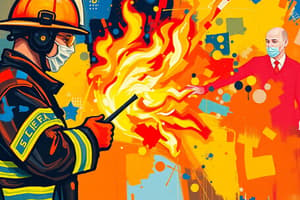Podcast
Questions and Answers
According to the policy, what is the primary role of St. Johns County Fire Rescue?
According to the policy, what is the primary role of St. Johns County Fire Rescue?
- To provide emergency medical treatment but not necessarily transport patients
- To provide emergency medical treatment and transport for all EMS calls (correct)
- To determine the best course of action based on the patient's condition
- To assess the need for transport and provide treatment only if necessary
What is the relationship between the actions of EMTs and Paramedics in the field and the Fire Rescue Medical Director (MD)?
What is the relationship between the actions of EMTs and Paramedics in the field and the Fire Rescue Medical Director (MD)?
- The MD has no legal responsibility for the actions of EMTs and Paramedics
- The MD is solely responsible for the actions of EMTs and Paramedics
- The actions of EMTs and Paramedics are considered the delegated practice of the MD (correct)
- The actions of EMTs and Paramedics are independent of the MD's authority
If an EMT or Paramedic makes a decision based on poor judgment, who bears the liability?
If an EMT or Paramedic makes a decision based on poor judgment, who bears the liability?
- The liability is shared between the EMT/Paramedic and the Medical Director
- The EMT or Paramedic bears the liability for their own poor judgment (correct)
- The Fire Rescue Medical Director bears the liability
- The EMT or Paramedic bears no liability
According to the policy, what should guide the decisions made by Fire Rescue personnel regarding treatment and transport?
According to the policy, what should guide the decisions made by Fire Rescue personnel regarding treatment and transport?
Who is ultimately responsible for decisions made by Fire Rescue, such as not treating or not transporting a patient?
Who is ultimately responsible for decisions made by Fire Rescue, such as not treating or not transporting a patient?
What is the expectation of citizens who call for emergency medical services from the Fire Rescue Department?
What is the expectation of citizens who call for emergency medical services from the Fire Rescue Department?
Informed Consent requires the patient to:
Informed Consent requires the patient to:
What is Implied Consent for emergency treatment?
What is Implied Consent for emergency treatment?
What must Fire Rescue personnel ensure before a patient refuses treatment?
What must Fire Rescue personnel ensure before a patient refuses treatment?
When can emergency treatment be undertaken under implied consent?
When can emergency treatment be undertaken under implied consent?
In scenarios where a minor does not require transport, who can they be released to?
In scenarios where a minor does not require transport, who can they be released to?
What does the term 'Treat/Transport' refer to?
What does the term 'Treat/Transport' refer to?
'No Treatment' decision is usually made by:
'No Treatment' decision is usually made by:
'No Transport' decision can be made by:
'No Transport' decision can be made by:
'No Patient' decision is made by:
'No Patient' decision is made by:
'Consent Refusal' implies that:
'Consent Refusal' implies that:
What is the purpose of this policy?
What is the purpose of this policy?
Who does this policy apply to?
Who does this policy apply to?
What is the role of EMS personnel when dealing with a dying patient?
What is the role of EMS personnel when dealing with a dying patient?
What is the purpose of the Florida-Do Not Resuscitate Order (FL-DNRO) form?
What is the purpose of the Florida-Do Not Resuscitate Order (FL-DNRO) form?
What are the requirements for a valid FL-DNRO form?
What are the requirements for a valid FL-DNRO form?
What should Fire Rescue personnel do if they have any question about the validity of a completed FL-DNRO form?
What should Fire Rescue personnel do if they have any question about the validity of a completed FL-DNRO form?
What does the presentation of a valid FL-DNRO form mean for Fire Rescue personnel?
What does the presentation of a valid FL-DNRO form mean for Fire Rescue personnel?
How can a FL-DNRO form be revoked?
How can a FL-DNRO form be revoked?
What is the purpose of the Patient Identification Device mentioned in the policy?
What is the purpose of the Patient Identification Device mentioned in the policy?
What should Fire Rescue personnel do if a patient does not have a valid FL-DNRO form or other DNRO documentation?
What should Fire Rescue personnel do if a patient does not have a valid FL-DNRO form or other DNRO documentation?
What is the primary purpose of the text?
What is the primary purpose of the text?
Which of the following is NOT a factor that can determine the destination facility?
Which of the following is NOT a factor that can determine the destination facility?
What is the primary reason Fire Rescue may deny a patient's or physician's requested destination facility?
What is the primary reason Fire Rescue may deny a patient's or physician's requested destination facility?
What is the primary purpose of having patients or families sign a waiver of liability when requesting transport to a stand-alone emergency department?
What is the primary purpose of having patients or families sign a waiver of liability when requesting transport to a stand-alone emergency department?
When is Fire Rescue permitted to transport a critical patient to a stand-alone emergency department, even if it is not the recommended destination?
When is Fire Rescue permitted to transport a critical patient to a stand-alone emergency department, even if it is not the recommended destination?
What is the role of law enforcement in patient transport?
What is the role of law enforcement in patient transport?
Which of the following conditions would NOT be appropriate for transport to a stand-alone emergency department, according to the text?
Which of the following conditions would NOT be appropriate for transport to a stand-alone emergency department, according to the text?
What is the primary responsibility of E.D. staff according to the text?
What is the primary responsibility of E.D. staff according to the text?
What is the primary factor that Fire Rescue considers when a patient or family requests transport to a stand-alone emergency department against their recommendation?
What is the primary factor that Fire Rescue considers when a patient or family requests transport to a stand-alone emergency department against their recommendation?
Which of the following is NOT a type of destination facility determination mentioned in the text?
Which of the following is NOT a type of destination facility determination mentioned in the text?
What criteria must a DNRO document include for Fire-Rescue personnel to honor it?
What criteria must a DNRO document include for Fire-Rescue personnel to honor it?
In the case of an unquestionably non-resuscitatable medical patient, what confirmed condition is necessary in 2 leads to waive the need for asystole confirmation?
In the case of an unquestionably non-resuscitatable medical patient, what confirmed condition is necessary in 2 leads to waive the need for asystole confirmation?
Under what circumstances may a traumatic cardiac arrest patient be presumed deceased without initiating resuscitation?
Under what circumstances may a traumatic cardiac arrest patient be presumed deceased without initiating resuscitation?
What action should be taken if a patient is pronounced DOA and not under Hospice care with no valid DNRO form?
What action should be taken if a patient is pronounced DOA and not under Hospice care with no valid DNRO form?
In what scenario will resuscitative efforts be continued in the transport unit and transport initiated to the chosen destination?
In what scenario will resuscitative efforts be continued in the transport unit and transport initiated to the chosen destination?
Why might some healthcare providers call 911 even when dealing with patients enrolled in hospice care?
Why might some healthcare providers call 911 even when dealing with patients enrolled in hospice care?
What should personnel do after determining a DOA at the scene if no signs of trauma or foul play are present?
What should personnel do after determining a DOA at the scene if no signs of trauma or foul play are present?
According to the policy, when resuscitation efforts are stopped, what should personnel NOT do?
According to the policy, when resuscitation efforts are stopped, what should personnel NOT do?
What is one of the primary reasons for the policy regarding death with dignity?
What is one of the primary reasons for the policy regarding death with dignity?
If resuscitation efforts are stopped, and the patient has been removed from the scene to a transport unit, what should personnel do?
If resuscitation efforts are stopped, and the patient has been removed from the scene to a transport unit, what should personnel do?
When a death has occurred, what responsibility do Fire Rescue personnel have towards the patient's family?
When a death has occurred, what responsibility do Fire Rescue personnel have towards the patient's family?
In the event of unquestionable death criteria, what should personnel NOT do to the victim?
In the event of unquestionable death criteria, what should personnel NOT do to the victim?
Which of the following statements is NOT supported by the policy?
Which of the following statements is NOT supported by the policy?
What is considered 'treatment' in the context of EMS calls?
What is considered 'treatment' in the context of EMS calls?
In which scenario can Fire Rescue make a decision that no transport is required without it being documented as patient refusal?
In which scenario can Fire Rescue make a decision that no transport is required without it being documented as patient refusal?
What action is necessary if a patient refuses all care or definitive treatment by Fire Rescue?
What action is necessary if a patient refuses all care or definitive treatment by Fire Rescue?
Under what conditions can a patient make the decision not to be transported?
Under what conditions can a patient make the decision not to be transported?
When does a 'no transport' decision require a Patient Refusal Form to be completed?
When does a 'no transport' decision require a Patient Refusal Form to be completed?
What must be documented when a decision is made not to transport a patient?
What must be documented when a decision is made not to transport a patient?
Under what conditions can a 'no patient' disposition occur?
Under what conditions can a 'no patient' disposition occur?
'Abandonment' in an EMS context refers to:
'Abandonment' in an EMS context refers to:
Study Notes
DNRO and DOA Policies
- The policy establishes procedures for DNRO (Do Not Resuscitate Order) and DOA (Deceased on Arrival) responses, applying to patients of all ages, including SIDS victims.
- The policy cannot address all possible contingencies, so personnel will attempt resuscitation according to procedures when in doubt.
Florida-DNRO Form
- The Florida Department of Health's FL-DNRO form identifies people who do not wish to be resuscitated in the event of respiratory or cardiac arrest.
- The form must be signed by the patient, physician, and witnesses, and meet specific criteria to be valid.
Honoring DNRO Forms
- Fire Rescue personnel will honor a FL-DNRO form if it meets all the required criteria, including:
- Presented in its original form or a duplicated version on yellow paper.
- Signed by the patient, physician, and witnesses.
- Verified patient identification.
- If the FL-DNRO form is valid, CPR should not be initiated, but comfort care measures and treatment for other medical conditions can still be performed.
Revoking a DNRO
- A DNRO can be revoked at any time by the patient, healthcare surrogate, proxy, or court-appointed guardian.
- Revocation can be in writing, by physical destruction, or by orally expressing a contrary intent.
DOA Medical-Unquestionable Death
- For non-trauma patients, the following criteria must be met to confirm death:
- Unresponsive.
- Apneic.
- Pulseless without heart tones.
- Asystole confirmed in two leads (can be waived if signs of decomposition are present).
- Unresponsive pupils.
- No measurable blood pressure.
- Verified down time >30 minutes (except in drowning or hypothermia cases).
Trauma-Unquestionable Death
- Traumatic cardiac arrest patients may be presumed deceased and resuscitation not initiated if they meet one of the following criteria:
- Open cranium with exposed brain tissue.
- Decapitation.
- Severed trunk.
- Pulseless and apneic with prolonged inaccessibility to care.
Post-DOA Procedures
- If the patient is not under Hospice care and did not present a valid DNRO form, the body will be left at the scene for investigation by law enforcement.
- Fire Rescue personnel will assist in respectful placement of the body and consult with the family regarding their wishes.### Death Criteria
- In instances of unquestionable death, the victim's body will not be disturbed unless necessary to determine death.
- After resuscitation efforts are stopped, disposable medical equipment will not be removed from the victim's body.
Resuscitation Efforts
- If resuscitation efforts are stopped, they will be continued in a transport unit and initiated to the closest Emergency Department.
- Personnel will notify law enforcement officers of any scene changes or critical observations before leaving the scene.
Family Interaction
- Fire Rescue personnel should remember their responsibility to the patient's family when dealing with death.
- They should provide a calm and compassionate explanation of what is happening, ensuring "death with dignity".
- Respect for the patient's family is essential.
No Treatment
- "No Treatment" dispositions only include patients who refuse all care or definitive treatment by Fire Rescue.
- A patient assessment is considered treatment and will be properly documented in a patient care report.
- Refusing treatment requires the completion of a Patient Refusal Form.
No Transport
- Convincing a patient who requests transport that they do not need to go to the hospital is not acceptable or legal.
- A "no transport" decision can be made by the patient (or family/legal decision maker) or Fire Rescue.
- Patients can refuse transport if they are competent and fully informed of the assessment findings.
- Fire Rescue can decide not to transport a patient after a complete assessment.
No Patient
- A "no patient" disposition occurs when a patient cannot be found or when a scene requires no EMS intervention or assessment.
- If the patient cannot be found, efforts to locate them must be documented on the ePCR.
- Scenes that do not require EMS intervention or assessment require only response information documentation.
Abandonment
- Fire Rescue personnel cannot leave a patient until another equally or more competent health professional assumes responsibility for care.
- Exceptions include transporting a skilled nursing facility resident with Battalion Chief approval, or non-emergency transport with Battalion Chief approval.
- Fire Rescue units must remain on scene with a patient until transport arrives.
Studying That Suits You
Use AI to generate personalized quizzes and flashcards to suit your learning preferences.
Description
This quiz covers the policy and direction concerning consent and transport decisions for St. Johns County Fire Rescue personnel responsible for making medical decisions. It also addresses the expectations of citizens who call for emergency medical services.




